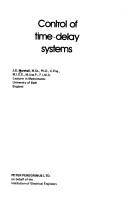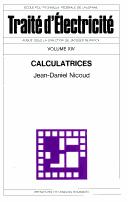| Listing 1 - 6 of 6 |
Sort by
|

ISBN: 0906048125 Year: 1979 Volume: 10 Publisher: London Peregrinus
Abstract | Keywords | Export | Availability | Bookmark
 Loading...
Loading...Choose an application
- Reference Manager
- EndNote
- RefWorks (Direct export to RefWorks)
Automatic control --- Delay lines --- Commande automatique --- Lignes à retard --- Time delay systems --- Time delay control --- Time delay control systems --- Time delay controllers --- Time-delayed systems --- Feedback control systems --- Process control --- Control engineering --- Control equipment --- Control theory --- Engineering instruments --- Automation --- Programmable controllers --- Lignes à retard
Book
ISBN: 0120127156 032315333X 1299472931 9780120127153 Year: 1979 Publisher: New York : Academic Press,
Abstract | Keywords | Export | Availability | Bookmark
 Loading...
Loading...Choose an application
- Reference Manager
- EndNote
- RefWorks (Direct export to RefWorks)
Control and Dynamic Systems V15
Automatic control. --- Control theory. --- System analysis. --- Network analysis --- Network science --- Network theory --- Systems analysis --- System theory --- Mathematical optimization --- Dynamics --- Machine theory --- Control engineering --- Control equipment --- Control theory --- Engineering instruments --- Automation --- Programmable controllers --- Programmation (mathématiques) --- Theorie du controle --- Controle automatique
Book
ISBN: 0879421258 0879421266 0471064866 0471064262 Year: 1979 Publisher: New York IEEE Press
Abstract | Keywords | Export | Availability | Bookmark
 Loading...
Loading...Choose an application
- Reference Manager
- EndNote
- RefWorks (Direct export to RefWorks)
Automatic control --- Frequency response (Dynamics) --- 681.5 --- stochastische processen --- multivariabele systemen --- multidimensionale systemen --- Frequencies of oscillating systems --- Oscillations --- Vibration --- Control engineering --- Control equipment --- Control theory --- Engineering instruments --- Automation --- Programmable controllers --- Automatic control engineering. Control systems, techniques, equipment. Cybernetic and automation technology --- Automatic control. --- Frequency response (Dynamics). --- 681.5 Automatic control engineering. Control systems, techniques, equipment. Cybernetic and automation technology

ISBN: 2604000180 2040155651 2604000024 9782040155650 9782604000181 Year: 1979 Publisher: [Lausanne] : Presses polytechniques romandes,
Abstract | Keywords | Export | Availability | Bookmark
 Loading...
Loading...Choose an application
- Reference Manager
- EndNote
- RefWorks (Direct export to RefWorks)
elektrische regeling --- Electronic control --- Commande électronique --- 681.5 --- 681.5 Automatic control engineering. Control systems, techniques, equipment. Cybernetic and automation technology --- Automatic control engineering. Control systems, techniques, equipment. Cybernetic and automation technology --- elektrotechniek --- Electrical engineering --- Commande électronique. --- CONTROLLERS --- ELECTRICAL ENGINEERING --- ELECTRONICS --- ELECTRICAL MOTORS --- REGULATORS --- DIRECT CURRENT MOTORS --- REGULATING --- CONTROL --- Monograph --- Electrical engineering. --- Electronics. --- Governors (Machinery) --- Centrifugal regulators --- Regulators --- Automatic control --- Physical sciences --- Electric engineering --- Engineering --- Elektronische besturing. --- Commande électronique.
Book
ISBN: 0126167508 9786612290473 1282290479 0080956564 9780126167504 9780080956565 Year: 1979 Volume: 148 Publisher: New York Academic Press
Abstract | Keywords | Export | Availability | Bookmark
 Loading...
Loading...Choose an application
- Reference Manager
- EndNote
- RefWorks (Direct export to RefWorks)
Vector-valued optimization problems in control theory
Control theory --- Automatic control --- Mathematical optimization --- Vector valued functions --- Théorie de la commande --- Commande automatique --- Optimisation mathématique --- Control theory. --- Automatic control. --- Mathematical optimization. --- Vector valued functions. --- Control systems --- Optimisation --- Applications of vector-valued functions --- Applications of vector-valued functions. --- Théorie de la commande --- Optimisation mathématique --- ELSEVIER-B EPUB-LIV-FT --- Functions, Vector --- Functions, Vector valued --- Functional analysis --- Functions of real variables --- Optimization (Mathematics) --- Optimization techniques --- Optimization theory --- Systems optimization --- Mathematical analysis --- Maxima and minima --- Operations research --- Simulation methods --- System analysis --- Control engineering --- Control equipment --- Engineering instruments --- Automation --- Programmable controllers --- Dynamics --- Machine theory
Book
ISBN: 1281860999 9786611860998 0387095381 Year: 1979 Publisher: Berlin ; New York : Springer-Verlag,
Abstract | Keywords | Export | Availability | Bookmark
 Loading...
Loading...Choose an application
- Reference Manager
- EndNote
- RefWorks (Direct export to RefWorks)
It is at least two decades since the conventional robotic manipulators have become a common manufacturing tool for different industries, from automotive to pharmaceutical. The new generation of robots are now being developed that can be categorized in two groups; redundant (and hyper-redundant) manipulators, and mobile (ground, marine, and aerial) robots. These groups of robots, known as advanced robots, have more freedom for their mobility, which allows them to do tasks that the conventional robots cannot do. Engineers have taken advantage of the extra mobility of the advanced robots to make them work in constrained environments, ranging from limited joint motions for redundant (or hyper-redundant) manipulators to obstacles in the way of mobile (ground, marine, and aerial) robots. Autonomous Robots: Modeling, Path Planning, and Control covers the kinematics and dynamic modeling/analysis of Autonomous Robots, as well as the methods suitable for their control. Drawing upon years of experience and using numerous examples and illustrations, Farbod Fahimi discusses: The application of autonomous robots including but not limited to redundant and hyper-redundant manipulators, and ground, marine, and aerial robots. Position and velocity kinematics of redundant and hyper-redundant manipulators. Obstacle avoidance in 2D and 3D workspace using the potential field method. Kinematic and dynamic models of autonomous robots. Control methods such as PID, feedback linearization, sliding modes as applied to autonomous robots. Autonomous Robots: Modeling , Path Planning, and Control is suitable for mechanical and electrical engineers who want to familiarize themselves with methods of modeling/analysis/control that have been proven efficient through research. This book presents the theoretical tools for analyzing the dynamics of and controlling Autonomous Robots in a form comprehensible for students and engineers.
Autonomous robots. --- Mobile robots. --- Robots --- Kinematics. --- Control systems. --- Robot control --- Robotics --- Kinematics of robots --- Robot kinematics --- Machinery, Kinematics of --- Autonomous robotic systems --- Automated guided vehicle systems. --- Field theory (Physics). --- Manipulators (Mechanism). --- Symplectic manifolds. --- Vibration. --- Mechanical engineering. --- Robotics and Automation. --- Vibration, Dynamical Systems, Control. --- Control, Robotics, Mechatronics. --- Mechanical Engineering. --- Engineering, Mechanical --- Engineering --- Machinery --- Steam engineering --- Cycles --- Mechanics --- Sound --- Robotics. --- Automation. --- Dynamical systems. --- Dynamics. --- Control engineering. --- Mechatronics. --- Mechanical engineering --- Microelectronics --- Microelectromechanical systems --- Control engineering --- Control equipment --- Control theory --- Engineering instruments --- Automation --- Programmable controllers --- Dynamical systems --- Kinetics --- Mathematics --- Mechanics, Analytic --- Force and energy --- Physics --- Statics --- Automatic factories --- Automatic production --- Computer control --- Engineering cybernetics --- Factories --- Industrial engineering --- Mechanization --- Assembly-line methods --- Automatic control --- Automatic machinery --- CAD/CAM systems --- Machine theory --- Field theory (Physics) --- Champs, Théorie des (physique) --- Variétés symplectiques.
| Listing 1 - 6 of 6 |
Sort by
|

 Search
Search Feedback
Feedback About
About Help
Help News
News